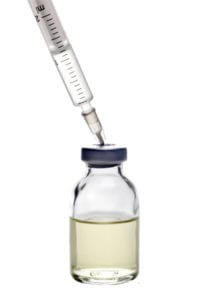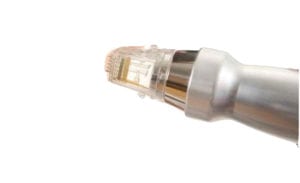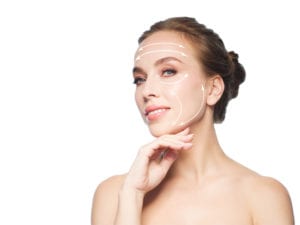In the 1895 novel The Time Machine, H.G. Wells describes a device that could turn clocks forward—or back. Now, many years later, that unthinkable idea is actually a working concept in the medical field. Anti-aging products and procedures offer a variety of options to ‘turn back time’ for patients who want to look years younger.
One of the most popular products to reverse signs of aging is the dermal filler. “Fillers can take off five to eight years or more in appearance,” says Dr. Troy Dowers of Bella Aesthetica in Creve Coeur. “We essentially replace the volume loss that occurs with rapid weight loss, illness or aging. We get rid of the tired, sunken look under the eyes or the loss of volume in the cheeks that causes sagging and wrinkles. If you couple fillers with good skin care, exercise and not smoking, you can get great results.”
Dermatologists and plastic surgeons have long pursued ways to replace lost tissue volume under the skin. “The original injectable filler was fat, harvested from the hips or abdomen through liposuction,” says Dr. John Chi, facial plastic and reconstructive surgeon at Washington University School of Medicine.
Fat transfer results were unpredictable, so Chi says doctors started using non-absorbable products like silicone, which later lost FDA approval. “Some of the other non-absorbable products are losing favor in general,” he explains. “Fat is still a viable option, but hyaluronic acid fillers are dominating the field now.” Soft-tissue fillers are among the most popular cosmetic procedures in the country, with 2.6 million applications in 2016 at an average cost of $644, according to the American Society of Plastic Surgeons. Slightly more than 2 million of the procedures used hyaluronic acid, which can last anywhere from six to 18 months. The fillers used for fine lines are so thin, the body breaks them down faster, Dowers notes. “Their longevity also depends on blood flow to the area,” he says. ”Fillers tend to dissolve quickly in the lips because there is so much vascular supply. The treatments last longer after you’ve had multiple treatments because a little bit stays behind each time.”
A rarely applied benefit of hyaluronic acid fillers is reversibility, Dowers adds. “The body breaks it down on its own, but if you don’t like the result, it can be reversed through a prescription with an enzyme that breaks down the acid” he says.
hyaluronic acid
- It occurs naturally in the body like fat, but delivers predictable results when used as a filler.
- It’s suitable for plumping fine lines or collapsed cheeks. Its density can be changed, depending on where it is injected and how much plumping is desired.
- Low-density is for fine wrinkles, and high density is for cheeks.
- It attracts water and can link to connective tissues in the body.
- There is evidence to support that it stimulates the face to make its own stem cells that produce connective tissue.
Another current device used to make patients look years younger is radiofrequency microneedling. “Radiofrequency is an electrical current, an applied energy along the electromagnetic spectrum,” explains Dr. Joseph A. Muccini, a surgical dermatologist at MidAmerica Skin Health & Vitality Center in Chesterfield. “It is applied with electrodes, an anode and a cathode, positive and negative. The concept is very simple: With heat, it causes an intentional, limited, superficial tissue destruction to create collagen remodeling.”
Carol Anderson, a certified aesthetic nurse specialist and owner of Nouveau MedSpa in Kirkwood, says radiofrequency creates heat wheals in the dermis, which signals to the brain that there is an injury. “The brain’s response makes that part of the body produce more collagen to repair the injury,” she says. “It can tighten, lift, smooth acne scars, and reduce fine lines and wrinkles.”
Procedures classified as “nonsurgical skin tightening” by the American Society of Plastic Surgeons include ultrasound and radiofrequency (RF) therapy, which were performed 306,089 times last year.
“It’s not such a new idea,” Muccini says, explaining that electrically generated heat has long been a medical tool applied to cauterize wounds or stop bleeding during surgery. “The tricky part was how to cauterize in the deeper layer of skin without injuring the surface, so the small device we use was quite the innovation.
Treatments may require several trips to a practitioner’s office. “Depending on the degree of need, we usually recommend a series of one to three treatments, six to eight weeks apart,” Anderson says. “Then you might maintain with one treatment every 12 to 18 months.”
Muccini adds that after the skin’s initial response, the collagen remodeling continues. “The nice thing is, there is no downtime,” he says. “You can come in at lunch and go back to work in 20 minutes, and nobody will know you had it done. You might be a bit red in the face, but that goes away very quickly.”
how it works: radiofrequency microneedling applicator
- The face is numbered so the patient doesn’t feel the needle insertion, just a little pinch and some heat.
- Radiofrequency is delivered through tiny, gold-plated, 34-gauge microneedles. Each applicator contains a few dozen of them.
- The needles are inserted repeatedly over the face. The needles are coated to allow energy release only from the tips when they have reached the selected depth.
- Needle depth is adjustable. To tighten the jaw line or neck, or address acne scarring, requires a deeper insertion. Fine lines are closer to the surface.
- Dermal radiofrequency treatments may require several trips to the doctor’s office.
innovations
Reversing time cosmetically is a $16.4 billion annual business. Breast augmentation and nose reshaping generate $1 billion each in patient costs, according to the American Society of Plastic Surgeons. Still more ($1.3 billion!) was spent on hyaluronic dermal filler treatments in 2016. Spending on nonsurgical skin procedures, including radiofrequency and ultrasound therapies, was $659.9 million. These numbers require continuous research and development. Below are two products new to the spotlight.
vollure
A fifth product has joined the Juvederm line of dermal fillers. Vollure provides longer-lasting plumping of medium-depth wrinkles due to a new technology for linking hyaluronic acid molecules.
“Vollure has hyaluronic acids that are more tightly bound together, so they resist the body’s natural breakdown and offer longer durability,” says Dr. Dee Anna Glaser, a SLUCare dermatologist and professor in the department of dermatology at Saint Louis University School of Medicine. “Our skin already contains hyaluronic acid, so it gives a very natural result.”
In clinical trials, Vollure injected in the nasolabial folds between the nose and mouth left results visible up to 18 months in 59 percent of patients. “Most fillers in that area only last six months to a year,” Glaser says. “I tell most of my patients to expect to come back every nine to 12 months for repeat or touch-up treatments when Vollure is used in the smile lines or nasolabial folds.”
Vollure is priced at around $750 per syringe, similar to the cost of other Juvederm products, she says. Those formulations address fine wrinkles and loss of cheek volume.
j-plasma
“J-Plasma is cold helium gas combined with a small amount of radiofrequency energy to create a new energy called plasma,” says Dr. Richard Moore, cosmetic surgeon and medical director of The Lifestyle Center in Ladue. “It is a nonsurgical face-lift that heats and then instantly cools the tissue. It vaporizes the skin’s surface off, and that energy tightens the skin and produces new collagen.”
He notes that it causes a fairly dramatic peel to lift and reshape the face. It also improves the skin’s quality by removing pigment irregularities and deep wrinkles that a face-lift or dermal fillers can’t fix. “Because it doesn’t use laser energy, we can get it right to the edge of the upper and lower eyelids,” Moore says. J-Plasma can take 10 years off your facial appearance, he notes. “Then you start aging forward, so in seven or eight years, you will look like you did before the procedure.”
J-Plasma first was designed for gynecologists, Moore says. “As they were destroying endometrial tissue, they noticed dramatic tissue tightening, which led to aesthetic uses. We also use it under the skin in other places on the body. I can get close to the same results as a tummy tuck on some women.”
The cost is about one-third the price of a face-lift and requires 10 days to two weeks of downtime.











